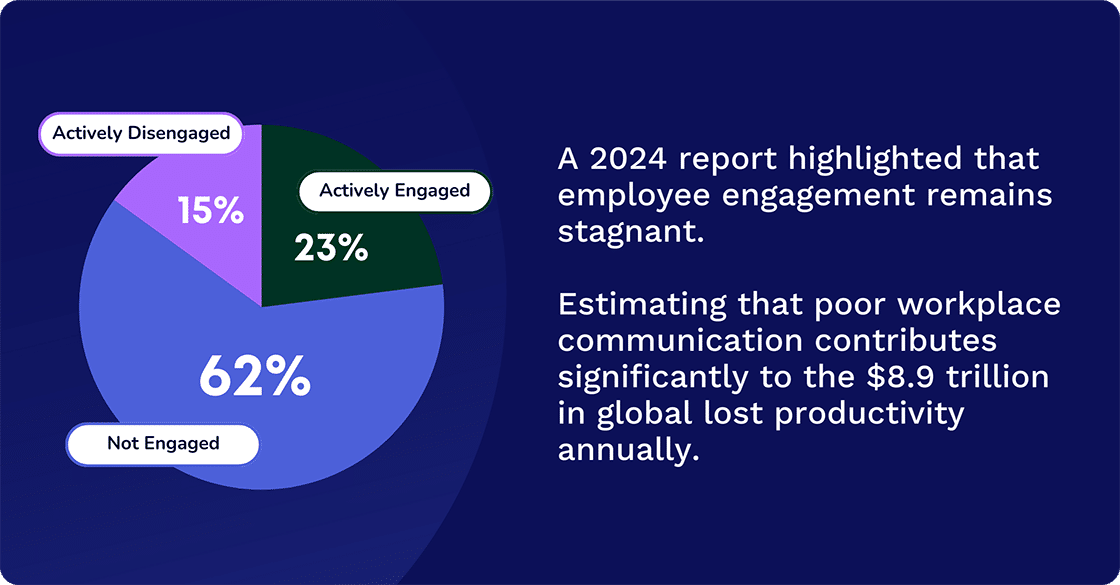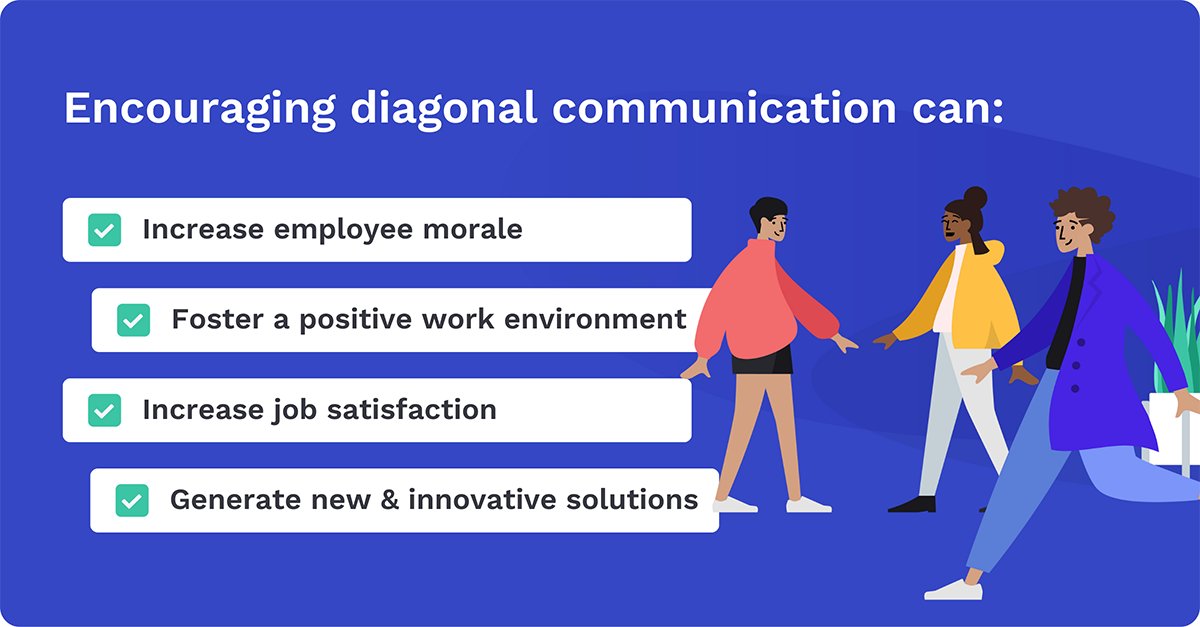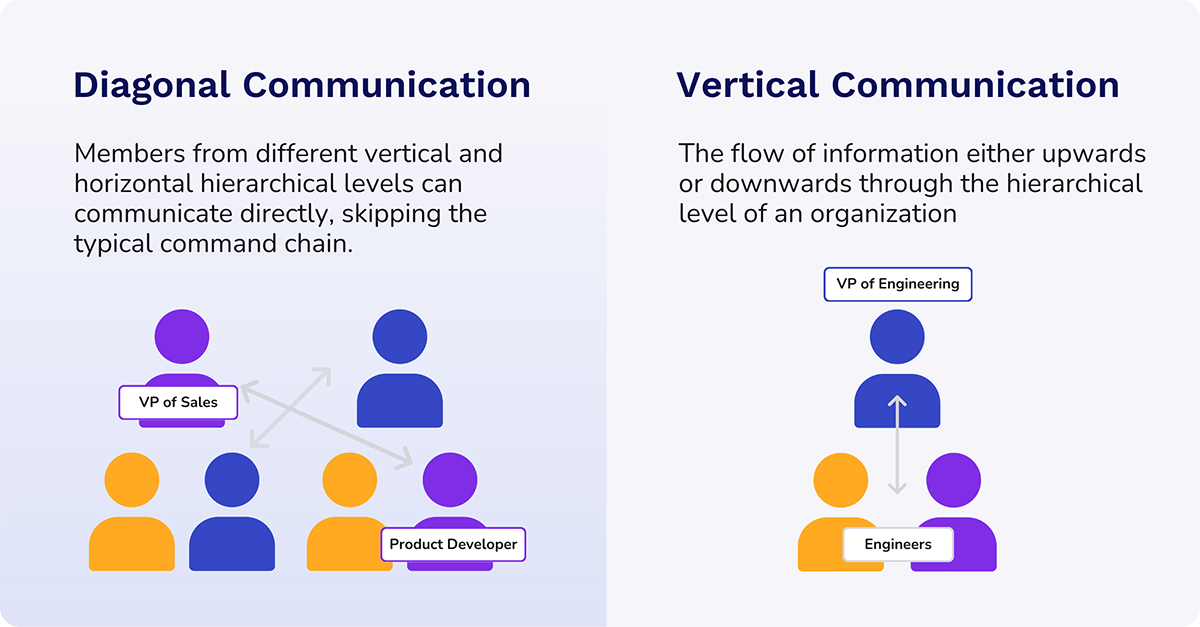Diagonal communication can often address issues more effectively than other more traditional forms of communication. We share free tips for success.

.webp)
Effective internal communication is the backbone of every successful organization. Learn the ins and outs of internal communications with our research-backed white paper.
Access NowIn today's highly-networked and interdependent business world, effective communication is key to ensuring seamless operation and achieving organizational goals. There are many different types of communication, and they all play a role.
One we don’t hear a great deal about is diagonal communication. Rather than downward communication that flows from management to employees, or upward in the other direction, diagonal communication allows unimpeded information to flow across various organizational levels and departments.
In this post, we’re going to explore the concept of diagonal communication, its benefits, challenges, and how it contrasts with other types of communication. We will also look at practical examples and offer valuable insights into enabling diagonal communication in any workplace.
Research indicates there are multiple problems resulting from issues related to a lack of communication of all types. The result is that a large percentage of the global workforce is dissatisfied and disengaged - and it’s costing U.S. organizations trillions of dollars every year.
Gallup’s State of the Global Workplace 2024 Report highlights that global employee engagement remains stagnant, with only 23% of employees actively engaged in their work, 62% not engaged, and 15% actively disengaged. It further estimates that poor workplace communication contributes significantly to the $8.9 trillion in global lost productivity annually, with a notable portion stemming from the U.S.
Importantly, the Gallup report highlights that “employee engagement is associated with hope for the future.
The Harris Report and Grammarly’s 2023 The State of Business Communication focused more on smaller corporations with at least 150 employees. Their research puts the cost of ineffective communication at $1,2 trillion annually.
McKinsey & Company reports in its The State of Organizations 2023 report that more than two in five business leaders surveyed (43%) refer to “a lack of communication about purpose.” Close to a third (32%) say there isn’t insufficient support for living out individual purpose in their organizations. The report also provides evidence of lost productivity costing $1 trillion a year and 12 billion working days being lost annually because of employee anxiety and depression.

While all the reports quoted here vary in content and context, they all have a common message. Communication in the business world is vital, but because it is so often ineffective, it’s costing not only dollars, but impacting on employee morale, engagement, and performance.
As mentioned above, we’ve chosen to focus on diagonal communication.
Also known as cross-functional or crosswise communication, diagonal communication, involves sharing information that cuts across work areas and hierarchical levels. The term encapsulates the broad aspects of horizontal communication (interaction between members within the same organizational level) and vertical communication (up-and-down exchange within a hierarchy). But, unlike these traditional modes of internal communication, diagonal communication is uniquely complex, allowing a product developer, for example, to engage directly with the vice president of a different department.
As such, diagonal communication can be used successfully to settle issues that may not be readily resolved through either vertical or horizontal channels alone. Its significance lies in its ability to dismantle organizational silos, promoting a more interconnected and streamlined flow of information.
Ultimately, diagonal communication can play a pivotal role in problem-solving, fostering innovation, and addressing challenges that necessitate input from multiple sectors within one organization.
Diagonal communication channels can also include formal channels such as important emails, customer service calls, and team meetings, as well as more casual interactions like informal conversation in a friendly atmosphere. These channels promote fast-flowing dissemination of information, which is essential in today's complex business environment. Whether it's about a product feature, a deadline, or just a simple friendly email reminder, diagonal communication provides an invaluable solution.
Team members should be encouraged to leverage communication tools in optimizing the diagonal communication process. This may involve sending instant messages via a team communication app or the more formal use of official email for important business communication. Different organizations may prefer different ways of communicating diagonally, but the outcome is usually the same. It results in improved collaboration, better job satisfaction, and a healthier work environment all around.
Incorporating diagonal communication into an organization's communication process has numerous benefits. It fosters a relational organizational structure, which encourages informal and formal interactions at various hierarchical levels. Stimulating diagonal communication channels along with vertical and horizontal interactions helps to break down barriers. It also builds trust among staff members and improves the collective ability to solve complex problems with innovative solutions.
There are very few studies that deal with diagonal interaction and communication. Additionally, there are few, if any, theories that explain the need for diagonal interactions. However,
Consider internal communications about a new product feature, for example. On its journey from the product developer who invents it, through various horizontal and upward communication channels to the vice president, the message might undergo modifications. However, with open communication channels enabled through diagonal communication, misunderstandings can be avoided. In this case, the developer can communicate directly about the feature to the vice president.
Diagonal communication can also increase productivity. It makes sense because staff members can address their concerns, ideas, or inquiries directly to the appropriate person regardless of their hierarchical level. As a result, this can significantly speed up the decision-making process. Similarly, it can enhance time management, reduce information overload, and bring about a palpable sense of engagement in the work environment.
Encouraging diagonal communication can lead to more effective work team-building activities and innovative solutions for complex problems. The ability for any employee to express their thoughts and ideas directly to decision-makers, without going through the formal chain of command, can generate new and innovative solutions to complex problems. This, in turn, can increase employee morale, job satisfaction and foster an overall positive work environment.
The bottom line here is that it makes perfect sense to improve diagonal communication.

Communication is imperative in the business world, but it doesn't come without challenges.
One major challenge is information overload. Having multiple communication channels such as emails, team communication apps, and formal meetings can become overwhelming for team members. Important emails may get lost in the influx, and this can reduce job satisfaction.
Another challenge is a time management issue, especially when communicating diagonally. More often than not, a product developer might spend a substantial amount of time trying to get a message across to the vice president, for instance. Being in different departments, they aren’t on the same page in terms of time. As a result, this level of hierarchical communication can hamper productivity.
Moreover, a complex business environment can create barriers to effective diagonal communication. For instance, team members may not have the necessary communication tools to express their innovative solutions to complex problems effectively. Here, the lack of open communication channels may undermine the diagonal communication process.
Vertical communication refers to the flow of information either upwards or downwards through the hierarchical level of an organization. These communications forms are known as upward and downward communication — or bottom-up and top-down communication.
Diagonal communication, on the other hand, represents a form of communication where team members from different vertical and horizontal hierarchical levels can communicate directly, skipping the typical command chain. This crosswise mode of communication is often seen in a complex business environment. It is mainly used when communication becomes necessary to solve complicated or intricate problems across departments.
In vertical communication, the information follows a structured path along the organizational structure. For example, a vice-president might pass a directive to his or her managers who, in turn, communicate the same message to lower-level staff. However, in diagonal communication, the vice-president can bypass managers and communicate directly with a product developer to speed up the communication process. This illustrates how diagonal communication helps information to flow fast.
But again, there are often challenges. Using diagonal communication channels can sometimes lead to confusion if not used properly. The reason, quite simply, is because diagonal communication usually bypasses the formal channels. For example, important emails may be missed if they aren't directed to appropriate personnel. So, it's critical to enhance the effective diagonal communication process through communication tools. Examples include friendly reminders for tasks and using team communication apps to organize and streamline communication. Doing this will also help to improve diagonal communication.

Horizontal communication, also called lateral communication, involves sharing information among employees on the same hierarchical level. Unlike diagonal communication, the horizontal type typically involves peers, making it a vital tool for encouraging collaboration. For this reason, it is also called peer-to-peer communication.
The graphic below shows the difference between horizontal on a single hierarchical level, and diagonal communication between different departments.
However, diagonal communication channels are broader than those used for horizontal communication. They allow information to flow from one department to another or across different management levels thereby encouraging diagonal communication.
For example, in improving product quality, a product developer (from the production department), could communicate directly with the customer service representative (from the service department). This internal communication is diagonal and focuses on innovative solutions to improve customer service. It’s a form of improved collaboration that aids creative problem-solving.
When used aptly, both horizontal and diagonal communication are tools for improving job satisfaction and enriching the work environment. However, it's important to remember that while diagonal communication can accelerate the resolution of issues, it’s important to avoid information overload.
An article published online in frontiers in Psychology during 2023 warns that information overload is exacerbated by the continuous evolution of digitalization. It is also impacted by the growing use of information and communication technology. Dealing with information overload: a comprehensive review suggests ways to avoid information overload. They include:
As the lines blur between vertical, horizontal, and diagonal communication, it becomes necessary for organizations to maintain a balance. A combination of these communication processes is usually an ideal choice. However, it’s important to ensure that everyone in the organization clearly understands the communication methods being used.

Researchers from Universitas Kristen Indonesia Maluku on the Spice Islands conducted a study on the effect of vertical, horizontal, and diagonal communication on employee performance. They also tested the most dominant variable affecting employee performance.
The motivation of the study was to maximize performance by focusing on communication, “ the main tool for perfecting relationships within the organization.”
The results showed that when used together, vertical, horizontal, and diagonal communication had a positive and significant 78/9% effect on the performance on employees from the Maluka Province Education and Training Agency employees of Maluku Province. Overall, the horizontal channel of communication was the most dominant variable (64.9%) affecting the performance of these employees.
While they concluded that diagonal communication affects performance, it wasn’t being utilized correctly. A major problem was “the existence of egoism” in the two units studied, each considering their unit better than others. The solution the researchers came up with was to increase physical interaction and both formal and informal communication between these units, which were at different levels of the organizational hierarchy.
Here are some instances where diagonal communication proves essential:
So, you can see that embracing diagonal communication not only breaks down silos but also enhances organizational agility and responsiveness.
Enabling diagonal communication involves both promoting open communication channels and having the right communication tools. Implement a team communication app for a start. These platforms provide an interface for all team members from different departments to communicate directly. Tools like Slack and Microsoft Teams allow for this kind of crosswise communication, skipping the usual downward or upward communication rules.
You can also encourage diagonal communication by structuring your staff meetings differently. Instead of having a traditional structure where information is passed from top management downwards, have sessions where the floor is open to everyone. This encourages lateral communication and gives even the newest team members a chance to share their thoughts.
If you're dealing with information overload because of excessive horizontal type communication, a good way to manage this is by establishing formal rules for vital internal communications, such as guidelines for sending important emails or having a protocol for the use of the team communication app. Time management and scheduling tools also come in handy to ensure the communication process does not affect regular work.
Another tip for enabling effective diagonal communication is by providing team-building activities or informal social events where individuals from different departments can interact freely. This allows an information exchange on an informal level, which can complement the formal chains of business communication.
Lastly, as a leader, lead by example. Engage freely in diagonal communication. Be open to it, and promote it. If leaders participate in diagonal communication and promote the practice, team members are likely to follow suit. This can lead to an improved work environment with a better flow of communication.
Cerkl Broadcast provides a central hub for communication, whichever type you choose to use. Its highly successful omnichannel capability allows employees to choose which channel or channels they prefer to use. You can also use it to personalize messages aimed at different audiences or segments, avoiding confusion and information overload. Broadcast New Digest and Audience Management capabilities enable effective, flexible mass personal internal communications. Feedback and employee engagement surveys are great for increasing company culture and the communication that goes with it.
Another key capability of the platform is Email Blast which enables internal communicators to build their own email templates and send out any type of communication they want. By segmenting your audience, you can streamline communication and ensure it gets to the right people at the right time. It simplifies the process, which is exactly what you need for diagonal communication.
You can improve your internal communication strategy with Cerkl Broadcast and incorporate diagonal communication in your plan of action. Broadcast is versatile and powerful. If you want to enhance and improve your internal communications, Broadcast is a platform you need to explore. We can talk you through your options and all the possible capabilities you can incorporate to take your communications to another level.
What is diagonal communication? Diagonal communication involves interactions between employees from different departments and hierarchical levels. It is valuable because it facilitates the resolution of issues that may not be easily addressed via horizontal or vertical communication alone.
What is a diagonal communication example? One example is a team member discussing a project-related concern with a colleague in a different hierarchical level and from a different department. The motivation could be to gather diverse perspectives and insights into the project.
What is vertical, horizontal, and diagonal communication? Vertical communication flows up and down the hierarchy within an organization. Horizontal communication occurs between individuals or departments at the same hierarchical level. Diagonal communication involves interaction across different departments and hierarchical levels, fostering a more interconnected flow of information.